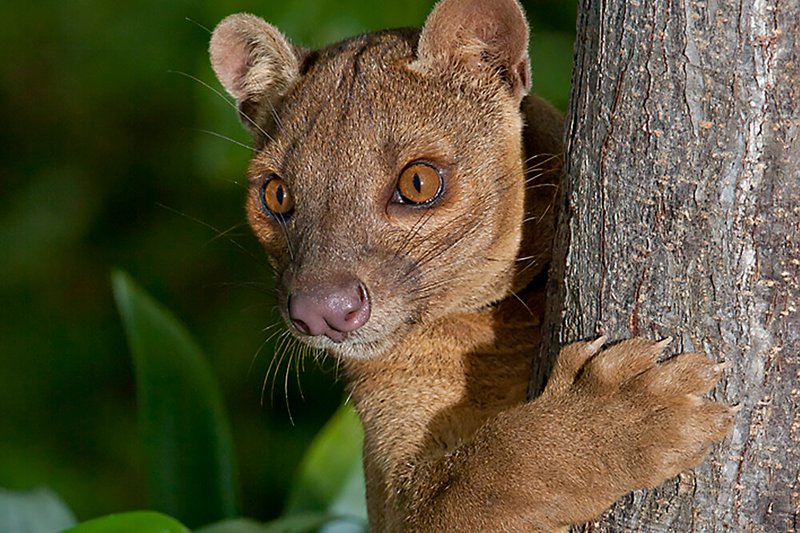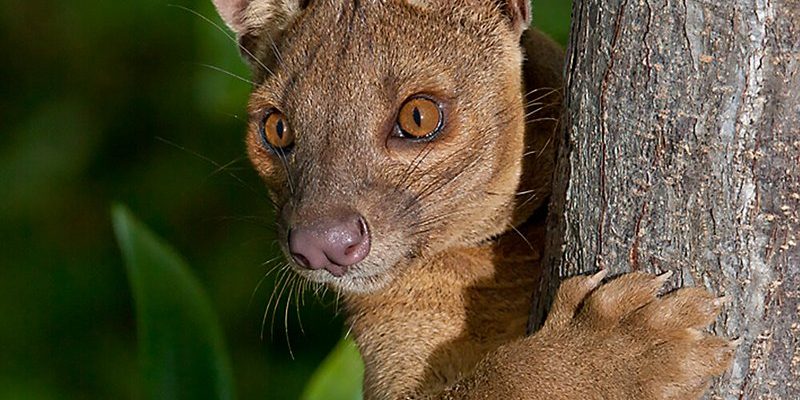
Fossas resemble a mix between a cat and a mongoose, thanks to their long, slender bodies and sharp claws. They’re not just cute; they’re built for their environment, which is anything but welcoming. Living in dense rainforests and rocky cliffs, fossas face challenges like food scarcity, competition, and severe weather. So, how do they manage to find their way in such harsh environments? Let’s dig deeper.
1. The Fossa’s Unique Physical Characteristics
Fossas have some fascinating physical traits that help them adapt to their challenging habitats. Their long limbs and flexible spines allow them to navigate through trees with remarkable ease. Think of them as the acrobats of the animal kingdom. This agility makes climbing and jumping from branch to branch seem effortless.
Their sharp retractable claws not only keep them safe but also help them grip onto branches securely. Imagine trying to climb a tree without a good hold—pretty tricky, right? These claws give fossas the stability they need to hunt for prey, like lemurs, birds, and small mammals. Plus, their keen eyesight and acute sense of smell enhance their ability to locate food, even in the dense foliage of Madagascar’s jungles.
2. Mastering the Art of Hunting
Fossas are carnivorous and incredibly skilled hunters. They thrive in a habitat filled with potential meals but must often work hard to catch them. Their primary target is the famous lemur, but they also eat various other animals. To hunt effectively, fossas rely on their stealth and patience.
They often stalk their prey silently, waiting for the perfect moment to strike. This patient approach is similar to how a cat might lie in wait before pouncing on a mouse. In harsh environments where food can be scarce, this method is crucial. If one hunting tactic fails, fossas can quickly adapt and try another. This flexibility in hunting techniques is vital for survival, ensuring they don’t starve in tough times.
3. Social Structure and Behavior
You might be surprised to learn that fossas are somewhat solitary animals. However, when it’s time to mate, they become more social. They communicate through vocalizations, scent markings, and body language, signaling to potential mates or rivals. This communication is essential in a dense forest where visibility is limited.
Fossas are also known for their territorial behavior. They will defend their home range vigorously, ensuring they have enough resources to survive. Whether it’s food or space, a fossa’s ability to defend what’s theirs is critical. In a world where resources can be limited, this determination helps them thrive against the odds.
4. Coping with Climatic Challenges
Madagascar is known for its fluctuating climate, from heavy rains to periods of drought. Fossas have developed several strategies to cope with these harsh climatic conditions. During the rainy season, they take advantage of the abundant food supply. However, when the dry season comes around, and resources dwindle, they rely on their adaptability.
Fossas can change their hunting habits based on what’s available. For instance, they might shift from attacking larger prey to smaller ones that are easier to catch. This shift in diet helps them survive when times get tough, showcasing their incredible ability to adjust to their changing environment. It’s like having a backup plan when your favorite restaurant is closed.
5. The Importance of Habitat Conservation
Sadly, fossas face threats from habitat destruction due to agriculture, logging, and human settlement. As Madagascar’s forests shrink, so does the fossa’s living space and food supply. This situation poses a serious risk to their survival.
Conservation efforts are crucial not only for fossas but for the entire ecosystem of Madagascar. Protecting their habitats ensures that these remarkable animals can continue to live and adapt in their harsh environments. It’s vital that we understand the interconnectedness of species and that protecting one often means protecting many.
6. Understanding Fossa Reproduction
Reproduction plays a significant role in the survival of fossas. They are seasonal breeders, with mating often occurring between September and December. After a gestation period of about three months, females give birth to litters of two to four kits. These babies are born helpless, relying on their mother for survival during the early weeks.
The mother’s role is critical; she must ensure the kits are safe from predators and teach them essential survival skills. Once they reach about five months old, the young fossas begin to explore on their own but stay close to their mother. This nurturing phase is vital, as it helps prepare them for the challenges ahead in their harsh environment.
7. How Ecosystem Dynamics Affect Fossas
Ecosystems are complex webs of life, and every species plays a part. For fossas, the health of their habitat directly influences their survival. With the decline of prey species like lemurs due to habitat loss, fossas face increasing challenges finding food.
Competition with other predators, such as birds of prey and snakes, also impacts their survival. It’s a constant battle for resources, where each species must adapt to the pressures of their environment. Understanding these dynamics is key to appreciating how fossas navigate their harsh surroundings.
8. The Future of Fossas in Madagascar
The fate of fossas hangs in the balance, largely dependent on conservation efforts and habitat protection. Organizations and local communities are working together to ensure the future of these incredible animals. Education, sustainable practices, and preservation of natural habitats will be crucial in maintaining the delicate balance of Madagascar’s ecosystem.
Investing in the future of fossas isn’t just about saving one species; it’s about protecting the rich biodiversity of Madagascar as a whole. After all, every creature has a role to play in our planet’s story. By supporting conservation initiatives, we’re not just helping fossas but also ensuring the survival of many other species that share their home.
In conclusion, fossas exhibit remarkable adaptability and resilience in their harsh environments. From their unique physical features to their clever hunting strategies, these animals embody the spirit of survival. As we recognize the importance of preserving their habitats, we can help ensure that fossas will continue to thrive for generations to come.

